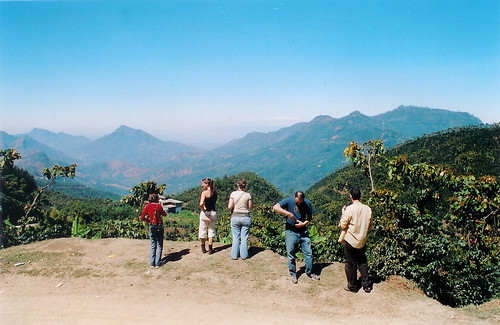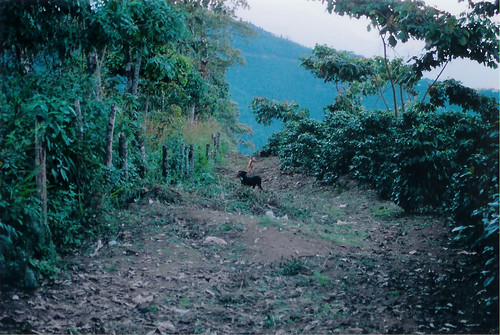
When we first made the turn to the road leading to the farm, we were told by Edwin Sr., 'don't get your hopes up about the pavement.' He was right, of course. While the early few meters were all nicely paved and surrounded by trimmed trees, it quickly became more forested areas as we moved up where the roads were bumpy and provided a more raucous ride. Mind you, it's not jungle as our late arriving colleagues opined, that would be in the lowlands, it was forest with some evergreen and mixed in the occasional bamboo clump.
One of the things that struck me the most as we headed up the mountains to the farm was how different the lower lands were compared to the higher altitudes. As we journeyed the final leg of our expedition to the farm with a beautiful view, we passed several other farms on the way up. It was these farms at the lower altitudes that looked so different than what we would see higher up. It's hard to explain, but as we followed our bumpy road twisting up the mountains in our little bus, the vegetation began to change and so did the look of the coffee trees planted around us.
We stopped at several points and really began to get a feeling for just how high up we were and how truly massive the mountains are in Huehuetenango(pronounced wayway... not hueyhuey).

It was not until later, as brave explorer Tristen was taking GPS measurements with farm manager Carlos from different areas of the farm, that we got a better handle on what kind of variations lay on each lot. From 5000ft to 7000ft with new plantings pushing even higher. Needless to say, we were impressed by the altitude and are certain it warranted the rating Super Hard Bean.
The altitude of these mountains also spoke to another feature you may not notice unless you spent an early morning at the farm. I remember the first morning sitting on the porch watching the sun slowly creep over and down the mountain, filling some crevices and restraining from lighting others. It moved over bit by bit until creeping up the porch and onto my lap. I realized then that the side of the ridge behind us may not get any sun for at least an hour more and then it dawned on me how each part of this mountain could get very different rain and sun. All those steep crevices and ridges presented different shade and rainfall options. Just looking at some of the slopes made you wonder how anyone could harvest some of these coffees without tumbling down the mountain or sliding off in the mud every time it rains.

It is the soil on the mountains that seems a funny thing to me. It sparked more than a few memories of childhood traipsing through the corn fields or running in the mountains. I remember when growing up in the hills of Appalachia in Southwest Virginia where the soil was clay and stuck to your shoes in intolerable clods. Then there were areas of the mountains where it just was different for whatever reason and darker richer soil or rockier sandier soil would suddenly prevail. In these mountains of Huehue, some areas were more like clay while others were darker and richer in color lacking that reddish hue. In some areas, large chunks of volcanic rock were laying around to remind us of the region's tumultuous past. After trekking up and down those trails, I'm sure more than one of us came a bit too close to the soil while barreling down those paths though I was lucky enough to avoid ending up with a terroir encounter.
So if you ever wonder why some of us out there opine about the value of micro lots and smaller and smaller units for the coffee, it largely has to do with the land. There might be a great lot out there where some perfect set of soil and shade comes together with just the right amount of rain to produce some tiny bit of perfection. Or so I imagine, as I am still dreaming about sitting on that porch as the sun creeps down the mountain while I enjoy the beautiful view.
